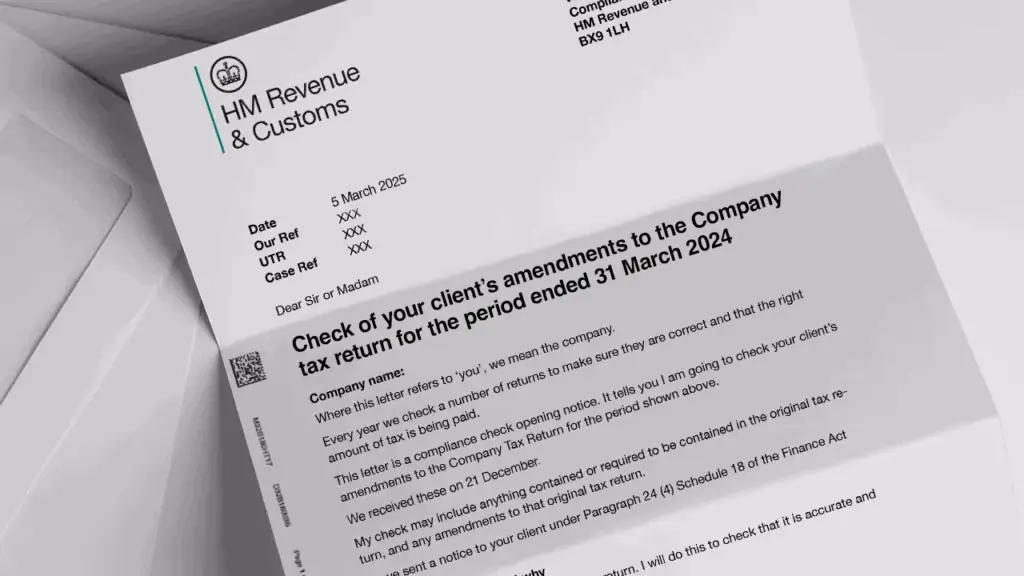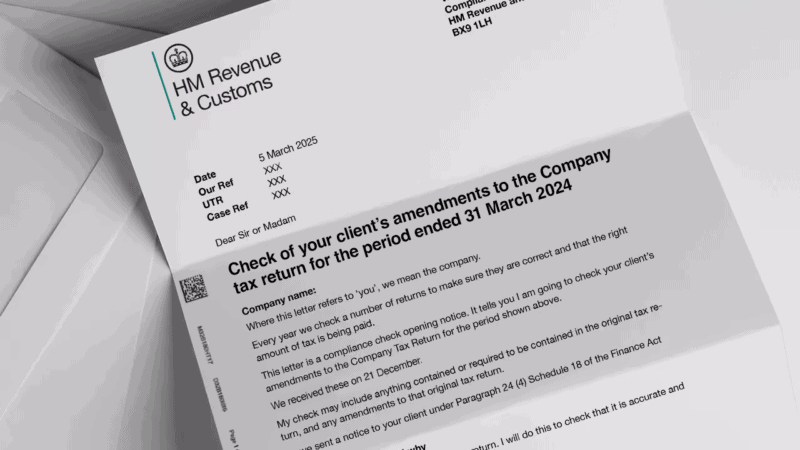If you are claiming R&D tax relief, it’s important to understand the correspondence you might receive from HMRC and what to do next. Before late 2022, most applications for R&D tax relief resulted in money hitting your bank account, with little or no direct communication between you and HMRC. But times have changed.
As we discussed in our R&D fraud and erroneous claims overview, HMRC has in recent times changed its approach to R&D claims in an attempt to prevent misuse. The creation of the ISBC team in late 2022, part of HMRC’s Campaigns & Projects team, has significantly shifted the compliance landscape.
So, what do HMRC R&D letters look like? What are they actually asking for? And most importantly, what do you need to do?
Deciphering correspondence from HMRC isn’t always simple, so we’ll look at some of the types of correspondence you might receive and some of the common jargon you’ll find within.
Before getting started, here’s a summary of what you need to know:
- Take any HMRC letter about your R&D claim seriously.
- Payment doesn’t equal approval – just because you’ve received cash doesn’t mean that HMRC has approved your R&D claim. They have processed it, but they may subsequently check that the claim is correct.
- R&D tax advice is a (largely) unregulated market and one that has attracted spurious advisers. You therefore may be exposed to potential risks without knowing it.
- Remember that you carry the risk associated with your R&D claim, not your adviser or accountant.
- HMRC are clamping down on erroneous claims and enquiries have risen from 1% to around 20%.
HMRC R&D eligibility letter
You might receive a letter from HMRC which is known in the tax world as a ‘nudge’ letter. This is not a compliance check or ‘enquiry’ letter (see compliance letter), however that does not mean it can simply be filed and ignored.
What is an R&D eligibility letter?
Eligibility letters, also known as ‘nudge’ letters, are typically used by HMRC as a proactive way to get companies to address potential errors in their R&D claims. These nudge letters are likely to feature the phrase: “help confirming you are eligible”.
Receiving an R&D eligibility letter like this does not necessarily mean anything is wrong with your R&D claim. But it should absolutely be taken as an opportunity to check that you are fully confident that your claim would withstand a compliance check.
Identifying a nudge letter
You need to be able to correctly identify an eligibility letter. In our experience, these letters follow a template. You can expect to see the heading: “Research and Development (R&D) tax relief – help confirming you are eligible”. This is the most obvious indicator. Another notable phrase to look out for is: “if you think the R&D carried out by the company does not meet the conditions, you should also make sure you report this accurately when filing your next Company Tax return.” These letters refer to the DSIT guidelines and include web links to relevant gov.uk pages too.
Example R&D nudge letter

Why have I received a ‘nudge’ letter?
Like we said, receiving an ‘nudge’ letter does not necessarily mean anything is wrong with your R&D claim. These eligibility check letters are another mechanism for encouraging businesses and their advisers to scrutinise R&D claims and avoid errors. HMRC are under pressure from the National Audit Office to reduce the number of errors in R&D claims that have been uncovered during compliance checks.
By sending out these advisory letters, HMRC hopes to encourage companies to look at HMRC’s own guidance on R&D claims and check they are comfortable with it. The plan is that companies will review their own claims without the need for an enquiry.
What I need to do
What you need to do next depends on whether you have prepared your claim yourself or used an adviser to help you.
- I prepared my R&D claim myself – in the correspondence you will see some links to HMRC’s guidance on R&D claims – these resources can be really useful. Ideally you’ll have used these to prepare your claim. If you are not already familiar, you have some reading to do!
If you don’t have time or are still uncertain, you can reach out to ForrestBrown. We will be happy to review your R&D claim and provide you with clear written advice explaining any risks and making practical recommendations for next steps.
If your claim does need to be amended to address any errors, an R&D tax adviser will know how to do this as efficiently as possible. Your accountant will typically be happy to help you as well, although they may recommend bringing in a specialist; they may even have one that they recommend.
- I worked with an R&D tax adviser to prepare my R&D claim – you should share the letter with them as soon as you receive it. They should be happy to advise you and answer any questions you have.
We don’t recommend settling for a general reassurance that everything is fine. Remember that you carry the risk associated with your R&D claim, not your adviser. It is therefore your adviser’s role to ensure you understand your claim and any risks within it. If you don’t, ask questions. And if you are not satisfied with their handling of your questions, seek a second opinion. Do not wait until you receive a compliance check letter or you will have missed the opportunity to address any errors with minimal fuss.

Act now
ForrestBrown will customise our service to match your requirements. We are experienced in supporting claims across a wide range of sectors and in liaising with HMRC. We can review your claim and support you with specific expertise on a consultancy basis. Contact us today.
- Telephone
- 0117 926 9022
- hello@forrestbrown.co.uk
HMRC R&D compliance letter
When you submit an R&D tax relief claim to HMRC, it should typically be processed by HMRC within 40 days. On occasion, HMRC will ask for more information to clarify any questions they might have. This process is known as an enquiry and it can be raised before or after your claim has been processed.
If you’ve received a letter from HMRC saying that they are conducting a compliance check into your R&D tax credit claim, this is the start of the ‘enquiry’. With an increased scrutiny on R&D claims from HMRC, these compliance check letters have become increasingly common and may be sent by one of three teams: Large Business Compliance, Wealthy/Mid-Sized Business Compliance or Individual/Small-Sized Business Compliance. Each team takes a different approach, but for all, it is vitally important that you take them seriously, and act quickly.
What is an R&D tax relief compliance letter?
An R&D tax relief compliance letter is HMRC’s way of communicating with you that they need more information about your R&D claim to check if the assessment has been made correctly. This process is known as an enquiry.
It is important to remember that compliance checks can look at your whole company tax return, so they can be quite broad in scope. The opening letter will tell you what HMRC are looking into – and if it’s your R&D claim, it will say just that.
Identifying a compliance check letter
The letter will explain that it is a compliance check opening notice. In the same way HMRC usually refers to taxpayers as ‘customers’, an enquiry letter rarely includes the word ‘enquiry’ in it. Instead, you’ll receive a letter titled:
“Check of the Company tax return for the period ended…”
The correspondence will also include some legislative references and probably some attachments. A number of factsheets will be included to help you understand your situation and how to correspond with HMRC. A common factsheet to be included is the CC/FS1a ‘About compliance’ checks. These factsheets can add bulk and an opening letter can run to nine or ten pages, but usually only one or two of these contains questions you need to answer. The rest will be background information and guidance.
Example R&D compliance check letter

Why have I received a compliance check letter?
HMRC will open enquiries into a proportion of all R&D tax credit claims. Due to a shift in approach, this proportion has increased. The reasons why HMRC might open an enquiry can vary. It might be related to your company and its status or about the nature of your R&D work.
The following are some of the more common reasons behind an HMRC enquiry:
- HMRC believe they have found an inconsistency – an aspect or detail that they do not find credible in your claim. This will be highlighted in their opening letter.
- HMRC are fact-finding following a change in your circumstances, such as an increased claim value.
- HMRC have questions about your tax return – which, although unrelated to R&D – has triggered the enquiry. R&D is usually then included for completeness.
- HMRC are focusing enquiries on a particular sector or type of technology to ensure they are approaching claims in the sector consistently. Businesses with certain Standard Industry Classification (or SIC) codes, are at higher risk of an enquiry.
What you need to do
The letter is the start of an HMRC enquiry and the most important thing at this point is to treat the matter with urgency. It can be tempting to delay putting a plan in place around your response. Sometimes the importance of the letter, the actions you need to take and the deadline can be lost in the many pages of jargon and guidance.
In short, if you’re facing an enquiry, do not ignore it. You’ll typically have 30 days to respond to the questions or requests in the letter, but make sure you check the date as the letter will have taken a few days to reach you if it has come by post and the deadline will be based on the date the letter was written. If this feels like a long time, it isn’t. You’ll ideally want your first response to be timely and thorough to avoid a last minute rush.
If you’ve worked with an R&D tax adviser to prepare your R&D claim, then share the letter with them immediately. They should quickly provide you with a plan for how they will manage the response. As with the nudge letters, if you are worried, you can seek a second opinion at this point.
Compliance checks can end in penalties if errors are found in your claim. How much will depend on how you have behaved during the enquiry. Missed deadlines or lapses in communication could count against you.
If you have concerns about your adviser or want expert support get in touch with James Dudbridge, Director at ForrestBrown. James and his team will discuss how best to protect your business. Our enquiry support team is made up of a former HMRC inspector, qualified chartered tax advisers and accountants, sector specialists and lawyers. This experienced team will step in to resolve the enquiry on your behalf, achieving the best possible result for your business. We offer SME or RDEC enquiry defence, or both, allowing you to focus on running your business.
ForrestBrown has helped a number of businesses who have found themselves the subject of a compliance check and needed our support to resolve the enquiry. In these cases, we have often found that the business itself was well-intentioned. Most companies set out to pay the right amount of tax and maintain a good working relationship with HMRC. In some cases, they have fallen victim to spurious marketing claims and poor tax advice, which has led them into a potentially difficult situation.
Many of these businesses only became aware of problems with their claims once they were in a formal compliance check, and unpicking these issues therefore takes time on both sides (HMRC and the company).
It’s important to point out that the first claim after your enquiry is critical. See how an HMRC enquiry set engineering firm CMB up for the future.
Contact ForrestBrown for the support you need
If you have received correspondence from HMRC in relation to your R&D tax claim, it’s important not to panic and not to ignore it. You should however act quickly and decisively. It may be that you find yourself without sufficient understanding of your claim or confidence in your adviser. If this is the case then ForrestBrown are able to review your claim and offer the support you need on a consultancy basis. Contact us today to find out more.

